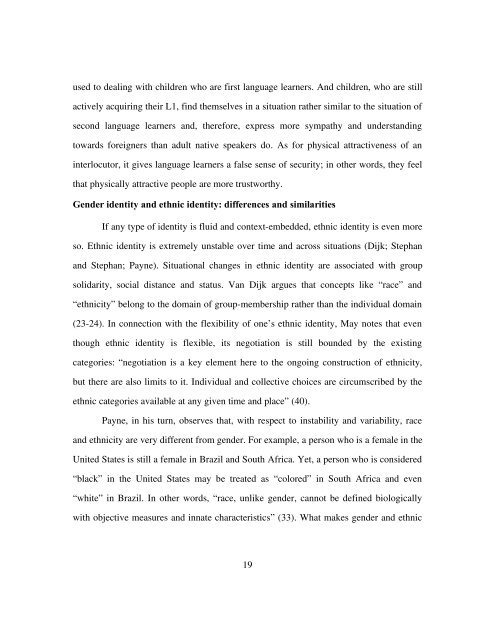Copyright by Tatiana Borisovna Segura 2008 - The University of ...
Copyright by Tatiana Borisovna Segura 2008 - The University of ...
Copyright by Tatiana Borisovna Segura 2008 - The University of ...
Create successful ePaper yourself
Turn your PDF publications into a flip-book with our unique Google optimized e-Paper software.
used to dealing with children who are first language learners. And children, who are still<br />
actively acquiring their L1, find themselves in a situation rather similar to the situation <strong>of</strong><br />
second language learners and, therefore, express more sympathy and understanding<br />
towards foreigners than adult native speakers do. As for physical attractiveness <strong>of</strong> an<br />
interlocutor, it gives language learners a false sense <strong>of</strong> security; in other words, they feel<br />
that physically attractive people are more trustworthy.<br />
Gender identity and ethnic identity: differences and similarities<br />
If any type <strong>of</strong> identity is fluid and context-embedded, ethnic identity is even more<br />
so. Ethnic identity is extremely unstable over time and across situations (Dijk; Stephan<br />
and Stephan; Payne). Situational changes in ethnic identity are associated with group<br />
solidarity, social distance and status. Van Dijk argues that concepts like “race” and<br />
“ethnicity” belong to the domain <strong>of</strong> group-membership rather than the individual domain<br />
(23-24). In connection with the flexibility <strong>of</strong> one’s ethnic identity, May notes that even<br />
though ethnic identity is flexible, its negotiation is still bounded <strong>by</strong> the existing<br />
categories: “negotiation is a key element here to the ongoing construction <strong>of</strong> ethnicity,<br />
but there are also limits to it. Individual and collective choices are circumscribed <strong>by</strong> the<br />
ethnic categories available at any given time and place” (40).<br />
Payne, in his turn, observes that, with respect to instability and variability, race<br />
and ethnicity are very different from gender. For example, a person who is a female in the<br />
United States is still a female in Brazil and South Africa. Yet, a person who is considered<br />
“black” in the United States may be treated as “colored” in South Africa and even<br />
“white” in Brazil. In other words, “race, unlike gender, cannot be defined biologically<br />
with objective measures and innate characteristics” (33). What makes gender and ethnic<br />
19

















